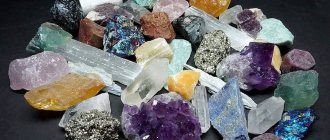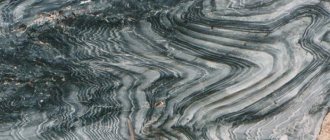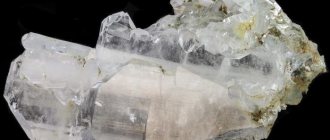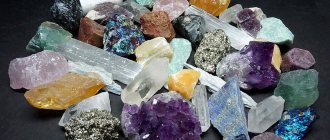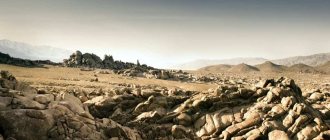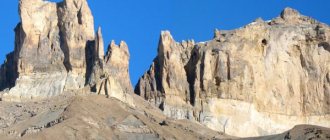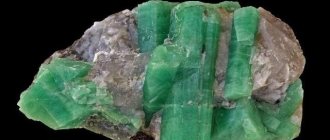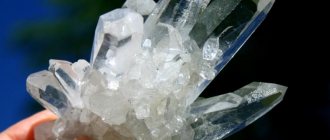“Stone man,” they say about people with a difficult character. The phrase is mysterious and multifaceted. Just like stones are the oldest inhabitants of the Earth. What kind of substance is this - body or substance? How are rocks and minerals formed? Why were they born? Why do some heal while others bring misfortune?
Basalt pillars in Iceland
What is a stone
The question “What is a stone?” worries more than one generation. For doctors, this is a symptom of a disease. In construction , art - a natural material for work. Many buildings, sculptures, paintings created from stone by famous architects and craftsmen came from the depths of centuries, this proves that nature does not have a more durable foundation.
Researchers call pieces of rock that way. They are created from minerals (Latin minera - ore), the lithosphere - the hard shell of the globe - consists of them. Science knows about 5,000 masterpieces of nature.
How many groups of minerals are there?
Currently, more than 5,336 mineral species have been identified, and every year the commission approves several dozen new ones, but only 100-150 minerals
widespread.
Interesting materials:
Why in tik tok and likes? Why is there no sound on Tik Tok? Why does Tik Tok say there is no internet? Why does the quality deteriorate in tik tok? Why does the sound disappear on Tik Tok? Why are likes removed from Tik Tok? Why does Viber say invite? Why is there no sound during a conversation in Viber? Why is there an error in Viber? Why does Viber call fail?
Types of classification of natural stones and minerals
Minerals are identified by their place of origin, composition and structure. In order to separate valuable specimens from decorative stones, a classification of natural specimens was invented according to common characteristics and differences.
Scientists and philosophers have been developing it for a long time. Today there are several techniques that gemologists use. The most popular of all existing types is considered to be the classification of natural stones and minerals by Kluge and Bauer. The German researcher Kluge divided raw materials into 5 groups. The first three were dedicated to precious samples.
Bauer's version was replenished with jewelry and semi-precious stones. Mineralogist Fersman diversified the document by dividing the types of precious stones into classes. The changes made by the scientist Kievlenko concern price and application. The latest edits were made by Melnikov, who proposed a classification of precious crystals into 3 varieties.
The development of jewelry making in the USSR, which occurred in the second half of the 20th century, forced the creation of a unified industrial methodology. It is still successfully practiced today.
Mining process
Natural stone is mined everywhere and on all continents. Typically, transportation is not cheap (the cost is influenced not only by the quality of the rock, but also by the method of extraction and transportation costs: when extracting stones from the Earth, it is very important to preserve the appearance of the rock).
Since natural stones have different strength and hardness, different methods and equipment are used to extract them.
To do this, the deposit is opened up, creating a vertical shaft leading into the quarry. Many countries use the drill-and-blast method and the air cushion method: using drills, they make a hole, lay a charge, or pump in air.
As a result, the rock falls into pieces (even though these methods are cheap, the valuable properties of the rock are lost because it is heavily crushed, which leads to significant losses of raw materials). A more expensive, albeit effective method is the stone-cutting method: it allows you to extract natural stone without much loss.
Dimensions
Natural stones come in different sizes: the largest stone is a rock (formed after a mountain with a large number of cracks is destroyed), followed by blocks, blocks, monoliths and smaller pebbles. Those used in construction can be both small in size and real giants: a large stone often has dimensions exceeding 10 cubic meters (these monoliths are especially valuable due to the difficulty of extraction and transportation). Large stones that do not have cracks are divided into:
- Blocks are large rectangular stones, the size of which exceeds ten cubic meters, they are used when laying foundations, cyclopean masonry, and in monumental monuments;
- Monumental - from 5 to 10 m3, monuments, sculptures, ceilings are made from it;
- Unique - size 2x1x1.5 m, monuments, sculptures, columns are created from it;
- Piece - the size exceeds 1 m3, they make quads, sculptures, vases, bowls, as well as blocks, cobblestones, and natural stone borders.
The size classification does not end there, for example, the height of boulders ranges from 20 cm to 10 m, crushed stone ranges from 5 to 15 cm, pebbles range from 1 to 10 cm, and thin plates are considered the smallest (they are used for cladding, in mosaics and stained glass) – from 1 to 10 mm.
Rock hardness
Another important characteristic of natural stone materials is such properties as their strength and durability, that is, the ability to maintain their qualities regardless of external influences. According to this indicator, natural stones are divided into:
- Highly durable - they begin to collapse after six hundred years, these include quartzites and fine-grained granites;
- Durable - begin to crumble after two centuries (coarse-grained granites);
- Relatively durable - destruction begins after a hundred years (white marble, dense limestone, dolomite);
- Short-lived - they begin to crumble after a quarter of a century (colored marble, porous limestone, gypsum).
When characterizing a rock, its structure is also taken into account: the size and shape of mineral grains, the degree of crystallization, granularity (how evenly distributed the mineral grains are and whether there are voids). For example, in order to find out which stone is more durable, just look at its components: a fine-grained structure is stronger than a rock with large grains or an uneven structure.
A large stone, the grain structure of which is uneven, is poorly resistant to environmental influences: mineral grains of different sizes expand differently when the temperature changes, which is why large stones crack, and if water gets into the cracks, natural stones continue to collapse.
Rocks and Minerals: What's the Difference?
These are links of one chain, of natural origin and based on known chemical elements. But there are differences regarding birth.
Rocks have the following characteristics:
- These are heterogeneous natural bodies that form the earth's crust.
- Formed by one or more minerals.
- Based on origin they are divided into 3 main classes.
- The composition and properties depend on the components and remain unchanged throughout its existence.
- They are used in many sectors of the economy, architecture, and design.
What are the remarkable minerals?
- These are solid natural substances with a relatively uniform chemical composition.
- They are the basis of rocks.
- They consist of different types of crystals with a symmetrical structure.
- They differ in weight, shape, hardness, color.
- They are used in industry, agriculture, high-tech industries, and the jewelry industry.
Rocks and minerals are non-renewable natural resources. Environmentalists are sounding the alarm, reminding us of this.
Is a stone a substance or a body?
To answer this question, one must generally decide what bodies and substances are? Teachers from the fifth grade answer this question to children in their natural history lessons.
All objects of living and inanimate nature are usually called bodies. While substances are precisely the material from which bodies are made. These concepts are closely interrelated. If you build a logical chain, it will take approximately the following form: bodies - substances - molecules - atoms - smaller structures within the nucleus.
By their nature, stones are products of rocks, pieces and fragments from them. Therefore, when answering the question: “Is a stone a substance or a body?” - you should pay attention to this fact. It should also be taken into account that the chemical nature of rocks is different, the substances from which they are composed are specific and not the same. Hence the conclusion: stones are both substances and bodies from the points of view of different sciences.
Rocks and minerals used by humans
Minerals serve people in everyday life and at work. No sector of the economy will survive without this. They are present in complex technical structures and common objects: dishes, furniture, mirrors. We owe them in almost all areas of life. Quartz is used in alarm clocks, as well as in gadgets. Fireworks - pyrotechnics contain copper, calcium, sodium. Without their participation there would be no film industry. But people would not have conquered space.
Where are stones used?
| № | Scope of application | Rocks, minerals |
| 1 | Construction of bridges, roads, buildings | Granite, mica, magnesite, flint, slate, cobblestone, marble |
| 2 | Cladding works | Granite, marble, labradorite, slate, rubble stone |
| 3 | Medicine, pharmaceuticals | Flint, mirabilite, gypsum |
| 4 | Sculpture, painting | Marble, ocher, cinnabar, graphite |
| 5 | Agriculture | Limestone |
| 6 | Manufacturing of precision instruments | Diamond, sapphire, quartz |
| 7 | Printing products | Limestone |
Every cook will remember salt, without which food loses its taste. But it is needed not only at the table. In spring and autumn, a sore throat is treated with a solution of a recognized antiseptic. Sodium ions contribute to the transmission of nerve impulses. It is estimated that people eat 4-6 kg of salt every year.
Zeolites, which remove radionuclides from the body, were evaluated after the Chernobyl accident. Then they saved thousands of lives. There is evidence of their potential in the fight against cancer. Medicine widely uses radioactive substances, which are extracted from similar natural raw materials.
Physical properties
From the point of view of the science of physics, a stone is a body. This means that its properties are characteristic, as for other similar objects: mass, melting and boiling points, density, color, taste, smell, etc.
However, everyone knows that a significant portion of stones have no taste, no smell, and are not capable of melting, but only crushing. Their colors are so varied that it is simply impossible to fit this indicator into a general framework. The palette of radiance of precious and semi-precious stones is complete: from black and white to bright blue, red, green, yellow and purple shades.
In general, we can distinguish several main groups of physical characteristics of stones, both natural and artificial (including precious ones).
- Strength and wear resistance. Based on this indicator, we can distinguish between strong (granite), medium (marble) and low strength (tuff) samples.
- Density. Corresponds to the previous indicator. They are divided into heavy - more than 2200 kg/m3 and light - less than this figure.
- Water absorption capacity, which is determined by the porosity of the structure.
- Acid resistance. The most resistant are granite and limestone. Marble collapses quite easily, as it enters into a chemical reaction with acids.
Thus, we can conclude that a stone is a substance or body of a natural nature, distinguished by a number of physical and chemical characteristics and of great practical importance in people’s lives.
How are stones formed in nature?
It is difficult for an ordinary person, far from science, to answer the question of how stones are formed and whether they grow. Looking at the large and small rocky fragments, it is difficult to imagine that the boulders could once have come from living creatures. According to the method of occurrence, science divides them into several types.
Living Trovanta stones grow and multiply in Romania. Amazing stones that gradually increase in size.
Igneous origin
Igneous origin is primary. Formation from magma occurred due to volcanic eruptions. The properties and structure were influenced by the composition, cooling rate of lava, and other external factors.
Sedimentary origin of rocks
Sedimentary origin is secondary . The formations were formed at the bottom of ancient reservoirs due to the accumulation of sediments, waste products of fauna and flora. They represent solid conglomerates.
Metamorphic rock formation
Altered rocks from igneous and sedimentary materials, created due to complete or partial transformation . The changes are caused by changes in pressure, temperature, hot gases, and mineralized springs circulating in the earth's crust.
Rocks from space - meteorites
Provoked by gravitational forces. During the passage of the Earth through meteorite showers, up to 2 tons of space “aliens” fall on it every year. In 2013, one of the asteroids entered the earth's atmosphere and became a meteorite. Having collapsed, it fell into Lake Chebarkul, for which it received its name.
Stones of endogenous origin
These are minerals born during the cooling of magma and the release of gases.
Exogenous natural formations
External solid bodies that appear on the surface of the earth's crust and in its upper part. They have 2 types of origin: sedimentary (sand, gravel), organic (limestone, peat, coal).
Regardless of the form and place of formation, each species is of particular value.
Why do stones appear in the garden every year? where?
1. Neighbors give money out of the kindness of their hearts.
2. Erosion, water and (or) wind, as a result of annual loosening of the soil.
3. Squeezing out stones under the influence of frost - ice remains under the stone longer, causing the stone to become higher than a certain height.
4. All the above reasons in combination.
Stones in the garden appear from deep layers of the earth. In our garden, when I still lived with my parents, small stones had to be selected every year when digging the ground. The basin stood in the middle of the garden, and that’s where my father and I put the pebbles. As soon as it was full, they carried it to the edge of the ravine and poured it out.
But every year the stones stubbornly climbed and climbed out of the ground, like weeds, which, moreover, are well watered and generously fertilized.
I also remember our school physics teacher explaining the emergence of stones from the ground to the surface by the fact that it is slowly pushed out by the water that is under the stone and freezes in cold weather, turning into ice.
As a person who at one time was heavily involved in treasure hunting, I realized that the earth is constantly in motion. It seems to us that the layers of soil are unshakable and static. Actually this is not true.
One of our women had a vegetable garden. I’ve been cultivating it all my life and one spring, while shoveling the soil, I discovered a gold piece at a depth of 5 centimeters. It somehow came out of the depths, apparently, it was once buried or lost. But the woman dug this garden conscientiously for 20 years and never found it, and then suddenly she found it.
Then, of course, everyone rushed to help her dig! )) But no one else found anything.
Source
What are natural stones made of?
Natural pebbles amaze with their diversity of composition. Surprisingly, most are based on one of two substances that affect their properties:
- Silicon or silicates. They demonstrate high strength, density, and resistance to temperature fluctuations.
- Calcium carbonate. Minerals formed from this compound are friable and resistant to acids and alkalis. They came from the remains of plants and animals compressed by time.
In addition to stones with the usual chemical composition, there is a miracle born in the depths of the earth to surprise and delight. This is a diamond. This unique creation contains only one element – carbon.
Yakut diamonds are called the kings of gems
Is it possible to take stones from the sea?
From a safety point of view, small marine rocks are also not suitable for sauna stoves. When heated, they will shoot out and explode. You cannot collect stones directly from the bottom of the sea.
Interesting materials:
How did Kursk submariners die? How are complex numbers multiplied? How to multiply three-digit numbers by three-digit numbers? How to multiply three-digit numbers by three-digit numbers? How will Lagertha die in the Vikings series? How to pack a TV for mailing? How to strengthen the cellular signal at the dacha? How to speed up Nox Player? How to speed up an old Samsung tablet? How to speed up the drying of moment glue?
TOP 10 natural (natural) stones and minerals used in construction
Thanks to the longevity of natural creators, such creations as the Egyptian pyramids, the Great Wall of China, the Roman Colosseum, the Acropolis of Athens and much more have been preserved. Among the special properties of materials, experts name:
- environmental friendliness;
- ability to keep warm;
- aesthetics;
- resistance to fire, moisture.
Positive performance characteristics allow them to be used in road surfaces, facing works, etc. But there are disadvantages. Some fossils contain background radiation, processes involving them can be labor-intensive, and their weight is not small. Nowadays, once popular materials are no longer used in load-bearing structures, arches, and columns.
Granite
Geologists call granite the calling card of the Earth. It is rich in colors, inexpensive, beautiful. Cold St. Petersburg is clad in gray granite. In pink – hot Yerevan. Unlike artificial stone , the original is resistant to damage and has unique patterns and properties. They decorate metro stations, embankments, clad buildings, and cover floors in theaters. Monuments are made from granite, and it is added to the composition when building roads. Among the disadvantages is the weight, which requires additional measures and restrictions during the work.
Granite
Marble
Translated from Greek, marble means “white, shiny.” The metamorphic base consists of calcite and organic compounds. Marble is harmless and can be processed. It is used in residential premises, interiors, sauna cladding. Large sculptures and furniture are made from large marble stones; souvenirs, tabletops, dishes, and decorative items are made from small ones. But this material has disadvantages: high price, heavy weight, susceptibility to acids.
Marble
Limestone
Sedimentary rock is formed at the bottom of oceans and seas. Natural stone materials contain corals, shell rock, and fish skeletons. Construction limestone is used in the construction of buildings; tiles, crushed stone, stone blocks, and fences are made from it. It is environmentally friendly and has good technical properties. Among the disadvantages of limestone: difficult transportation, low load-bearing capacity, low moisture resistance.
Limestone
Slate
The volcano native is several million years old. Slate has another name - flagstone. And also in an unpleasant manner - under mechanical influence, they disintegrate into plates and tiles. Indicators of hardness, color, properties depend on the composition. Siliceous shale is used in the production of crushed stone and sand-lime brick. Thin plates are used as facing stone, filler for roofing mastic, and road asphalt. Disadvantages of slate: high cost, weight, small color palette.
Natural Slate
Sandstone
Sandstone (savage) is a natural material of sedimentary type. The main component is sand made from natural minerals, which are responsible for strength. Calcareous savage is similar in hardness to granite. Large deposits have formed in areas that once served as reservoirs. Depending on the color, they are used for decorative and construction purposes. The Egyptian Sphinx, the Palace of Versailles, and many famous buildings in Rome are made of sandstone. Now we are going to make facing tiles and foundations.
Sandstone
Basalt
Basalt occupies a worthy place in the composition of rocks on Earth and other planets. From the Ethiopian language it is translated as “iron-containing”, “boiling”. This is a hint of the character forged in the volcano, and its main “ingredient”. Color and properties depend on the content. Strength and plasticity make it possible to use basalt in insulating materials, in the production of slabs, mineral sheets, and concrete. Eco-friendly, safe. The disadvantage is the high price.
Basalt
Flint
Among the rocks and minerals used by humans, flint occupies a place of honor. With its help, our ancestors once made fire and made weapons. Penetrating into rocks, flint is saturated with their composition, changing shape and color. Used in road construction. No cons found.
Flint
Zlatolit
Exists in the form of plate formations. The name is due to the presence of gold and silver in its composition. It is distinguished by its durability, long service life, and pearlescent luster. Noble metals and environmental elements on the surface protect against radiation and moisture. Combines with any materials and is used in interior decoration. There are practically no cons.
Zlatolit
Travertine
The second name is calcareous tuff. Polished, polished, ground slabs are used indoors. Bush hammered, sawn, brushed - when decorating facades. Eco-friendly, frost and moisture resistant. Affordable. There is a minus: it requires careful care.
Travertine
Labradorite
The breed owes its name to an island in North America. It is considered an excellent material for external and internal cladding. Durable, resistant to atmospheric testing. Manufacturers guarantee the absence of disadvantages. Except for the price.
Labradorite
Spheroids in the world
Massive spherical nodules of a nature similar to trovants are found in the sands of the beaches of New Zealand, in Kazakhstan on the Mangyshlak Peninsula, on the shores of the Pacific Ocean in California (USA), in the Valley of the Moon in Argentina, off the Pacific coast of Costa Rica, as well as in Brazil and Mexico , Egypt, Israel, China and other countries.
A fragment of a strata sandstone concretion, formed by the accretion of more than 50 spherical mineral formations, called the “Maiden Stone” is located in one of the most popular recreation areas in Moscow - Kolomenskoye Park. The pagans used it as an altar on which they made sacrifices to the gods.
Russian "trovants"
Mineral spheroids are also found in Russia. Round blocks come out of the ground in the vicinity of the village of Andreevka, Oryol region, and in the village of Boguchanka in the north of the Irkutsk region. In the section of a coal mine there are stone spheres that seem to be made of metal. Spherical boulders were found near the village. Wet Olkhovka in the Volgograd region, in the Izhma river (Komi Republic), as well as on the islands of the Franz Josef Land archipelago.
Of course, our “trovants” do not have such impressive sizes as Romanian boulders. In addition, they contain quartz-chalcedony materials, so they do not react to weather changes and do not reproduce.
4.4 / 5 ( 11 votes)
Advantages
The main advantages of artificial cladding are as follows:
- low price when manufacturing a product or purchasing a ready-made product;
- choice of color - when making the material yourself, you can choose an almost ideal palette;
- fewer flaws, defects, inclusions that are characteristic of natural materials;
- due to the denser surface, care is reduced to removing dust or cleaning with a damp cloth;
- delivery is significantly cheaper, since the location of the plant or even independent production eliminates long transportation from the production site;
- if additional quantity of material is required, then you can purchase any volume of exactly the same stone;
- simplified repair;
- the weight of stone blocks with the same texture is approximately 1.4-1.5 times lower than their natural counterpart, which greatly facilitates installation;
- an artificially aged surface will serve well for many years, but for a natural product it means rapid destruction;
- installation is also simplified due to additional elements.
How do ingredients affect quality?
Many believe that the structure and composition of artificial finishing affect the performance of the material. The statement is incorrect because strength depends on maintaining the recommended production technology, and not on the components used. Particles of sand, foam glass, expanded clay balls, marble chips and other additives in a ratio that does not exceed the norm do not make the material less durable.
Similarly, the type of surface - smooth or textured - does not affect. At the same time, it is worth treating it with water repellents to increase its service life. Then this material will not be afraid of moisture and other adverse atmospheric influences. The quality of a decorative stone determines its resistance to fracture. If the tiles crumble easily, then the material is of low quality, and paint coatings or other methods of influencing the durability of the finish will not bring results.
Decorative stone, which can be of natural or artificial origin, is often used for cladding. This is a durable material that provides reliable protection to load-bearing structures. Artificial stone has less strength and durability than natural stone , but at the same time it has a lot of other advantages - a variety of colors, shapes and types of finishing elements, ease of installation.
Varieties
There are several popular examples of natural stones that are used by people in landscape design and construction due to their strength, beauty and environmental friendliness.
- Marble, which can be of different shades and patterns (layered or spotted). Since ancient times it has been used as a stone for architectural structures. From a chemical point of view, it is calcium carbonate CaCO3.
- Granite. It is a material for finishing floors, walls, cladding buildings, creating incredible works of art (monuments, monuments, etc.). From a chemical point of view, it is a combination of feldspars, quartz and dark-colored minerals.
- Sandstone. It is used by people for paving sidewalks, building stairs, and laying foundations. Used since ancient times. Chemical composition: quartz and feldspars.
- Travertine. An extremely dense and strong stone, surpassing marble in hardness. It also has good frost resistance. It is used in construction along with granite and marble. Composed of calcium carbonate minerals.
- Tuff. A beautiful porous stone, quite loose. Used for design of garden plots and cladding of buildings. Chemical nature - calcium carbonate, silicon compounds, volcanic ash and compacted lava.
- Jasper is a beautiful colored stone used for decorative finishes and jewelry. It is a mixture of silicon compounds and iron oxides.
There are also such common stones as slate, basalt, dolomite, limestone and others, which are widely used in construction and are generally used by humans. Natural stone, a photo of which can be seen in the article, is one of the most popular materials for interior decoration today.
